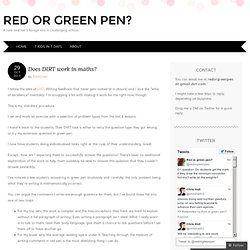

Stop writing feedback comments…..and see what happens! We are constantly trying out new ideas to ease workload and marking/feedback is always one area that my colleagues are keen to swop and share ideas on.

I know that others have the same concerns and that our huge blogs of shared practice are by far the most read, borrowed from and commented upon that we have published externally. I’m not going to put links in this post as they are all on our web-site and we are moving on at a rate of knots anyway. Over the Whit holiday I decided that it was time to try to suggest that we made a positive move towards trialling non written feedback. We had played at it with some great ideas already running and we had shared blogs from other schools such as Michaela to look at ideas from elsewhere whilst also setting up a well-being group and trying to reduce workload in key areas such as data collection. The Behaviour Guru: Tom Bennett's School Report. Marking mathematics exercise books - Life without Levels. December 15, 2015.

RAG 123. Marking is damaged, but not broken……..yet. I Believe it’s time to reclaim marking and make it our own again.

It’s time to establish the hard facts, analyse what the research tells us and debunk the myths. Ask any teacher across various educational contexts what is top 3 in terms of their workload burden and I predict this will always include marking; excessive, high frequency in-depth marking to be more specific. In fact, there is a wealth of evidence that rejects this practice, rendering it as ineffective and suggesting it’s reaching crisis point.
Claim Back Your Weekend! Marking: Keeping it Simple by @DianKenny. This is a re-blog post originally posted by Diane Kenny and published with kind permission.

The original post can be found here. Marking and feedback are not the same. Feedback is, we’re told, the most powerfully important invention in which a teacher can engage, but marking students’ books can be mind-numbingly tedious drudgery.

Because of this tension, many schools have introduced strict marking policies and work scrutiny schedules to make sure that teachers don’t shirk this crucial responsibility. But, the more I think about it, the more convinced I am becoming that marking and feedback are two quite separate things. Cambridge Dictionaries Online defines marking thusly: And here are two different definitions for feedback: Fast Feedback. Our first Magic Monday kicked off at lunchtime with a “Pedagogy Picnic”.

I drew the short straw had the honour of kicking things off first, with a 7 minute presentation on “Fast Feedback“. Here’s a summary of my presentation. The impact of feedback in raising attainment has been well documented by academics such as Dylan Wiliam, John Hattie and more recently by the Sutton Trust Education Endowment Foundation in their Toolkit findings. Written feedback can be a time consuming task though and the purpose of this presentation was to try to pull together a variety of methods that could speed up feedback, without compromising the quality of it. I wanted to share a range of strategies, rather than focus in more detail on a few.
Effective-marking-teachers-handbook-2013-2014-new. Marking: minimum effort for maximum pleasure. This is my eighth year as a secondary English teacher.

I teach a full timetable of lessons and it would be a fair estimate to say that I spend, on average, an hour a day marking… or in other words over 8 full days an academic year bent over a never-ending pile of biro-scrawled offerings. At the beginning of this year, I decided to take a step back. What is time well spent and what, quite frankly, is a waste of time? Embedding diaolgic marking.
What if you marked every book, every lesson. ‘God save thee, ancient Mariner!

From the fiends, that plague thee thus! — Why look’st thou so?’ —With my cross-bow I shot the Albatross. Making Feedback Meaningful. The 15 Minute Forum tonight was led by maths teacher Shane Borrett (@BorrettShane).

Shane talked us through how he has been working at ‘closing the feedback loop’ with a couple of simple strategies. As a starting point all students are given a ‘level ladder’ (like the one above) for each new topic, which is then stuck in their exercise book. This shows students where they are are and what they need to do in order to progress to their target level – in that particular topic. A similar document is also available for GCSE. At the end of each topic students are given a self assessment sheet, like the one above – again to stick in their book. Does DIRT work in maths? I adore the idea of DIRT.

Writing feedback that never gets looked at is absurd, and I love the “ethic of excellence” mentality. I’m struggling a bit with making it work for me right now, though. This is my standard procedure. I set and mark an exercise with a selection of problem types from the last 4 lessons. I hand it back to the students. I now have students doing individualised tasks right at the cusp of their understanding.
Marking: Boulder or Butterfly? Open book, read, tick, turn page, read, write comment, tick, tick, read, correct capital letters, tick, tick, correct spelling mistake, turn page, write comment, stamp, close book, next. And repeat. Thirty times. Then thirty more. Then thirty more. Marking: minimum effort for maximum pleasure. #blogsync - an initiative in educationalist blog synchronisation - EDUTRONIC. Marking: Minimum effort for maximum pleasure. Towards the end of this half term, we have had a steady stream of DHS teachers writing blog articles, to share what they have been doing in their classrooms - which is fantastic to see.
The most recent addition to this is English Teacher Andy Tharby (@atharby). In this article, Andy reflects on marking - with a view to making it more manageable, whilst not diluting how useful it is to his students. Please read on…… This is my eighth year as a secondary English teacher. Improving feedback in a 1:1 environment. It seems to be marking season at the moment. Not the season where marking occurs (we all know this to be nonseasonal) but instead the season during which multitudes of blog posts appear displaying various approaches to marking and student feedback. In Maths, providing feedback, next steps and encouraging students to reflect and improve on their work is notoriously a complicated affair – especially the next steps part. Mr Trussell Maths: Super Google Quiz Feedback. Freeing the Angel. 5. How can I mark books without burning out?
Appetising stuff? Use icons to set targets, save time and help them improve. Imagine you have five classes of thirty students, who you teach three times a week. Marking their books is the bane of every English teacher’s life. To mark every student’s book each week, it means correcting about 300 pages a week. One simple solution helps: use icons to set targets. Most marking is high effort, low impact. The problem with this for students is that it doesn’t help them improve. Instead, what would maximum impact, minimum effort marking look like? Don’t write out comments. Instead, get them to write them out.
Simple. Marking Matters. Marking For The Masses And Feedback For The Future. Students have a Google account set up via the school as they are under 13. Older students can use their own Google login if they have one. The students leave Edmodo up on one tab and open another tab. Students go to their Google Drive, create a document and use their notes from the starter activity to complete the task. DIRTy Work. Excuse the cheap pun of a title. How I cope with marking.